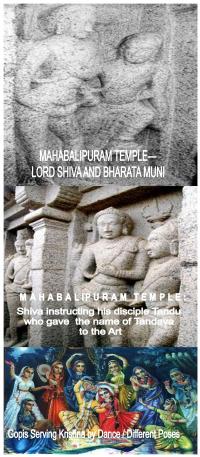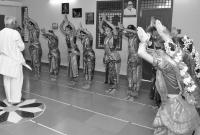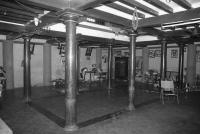 | According to Natya Sastra Sangraha, the science of Dramatic presentation was first taught by Brahma to sage Bharatamuni. Sage Bharatamuni then produced before Lord Siva the Three-fold Art of Pure Acting, acting accompanied by dance and pure dance, with the help of his troupe of Gandharvas (Heavenly Musicians) and Apsaras (Heavenly Damsels). Lord Siva was then reminded of his own Dance with energetic movements and had it taught to Bharatmuni by Tandu, the leader of his followers. He also had Lasya (the gentler and more graceful variety of Dance suitable for ladies) taught to Bharatamuni by Parvati who exhibited the Art in his presence. The Rishis (Bharatamuni and others) having learnt the Art of Tandava (male dance) from Tandu, taught it in their turn to Men; and Sri Parvati Devi taught the Lasya to Usha, the daughter of Bana, who in her turn taught it to the Gopis of Dwaraka; and from the Gopis, the art spread to the ladies of Saurashtra (Kathiawar), Gujarat, and from them to the other parts of the country. In this way the Art of Dance and Drama has been established by tradition. Tandav and Lasya are major parts of Bharatnatyam. To day what we are seeing, as beauty and grace, in Garba Lok Nrutya is reflection of Lasya only, we can say, other than Tamilnadu no other state symbolizes Bharatnatyam as Gujarat.
|
 | In old days under “GURUKUL SYSTEM”, Bharatnatyam students used to stay at ancestral home of Nattuvanar, where a separate hall was kept as practicing place and this hall was known as SHRAMA KOODAM or SILAMBU KOODAM. The students were required to do rigorous practice in “ASOORA SADHANAI “ which means they were demanded to practice like a Demon ( Rakshasa) to achieve perfectness. The floors of some halls were uneven due to the constant stamping of feet by generations of Bharatnatyam dancers in practice. Mostly the practices were done in the early morning. |
 | Nattuvan Chavdi in Thanjavur was gifted by King Tulaja II (b.1763) to Subbrayan Nattuvanar (1758-1814) son of Gangaimuthu Nattuvanar (b. 1737) and father of famous Tanjai Nalwar (Pillai brothers Chinnaya, Ponnaiah, Shivanand and Vadivelu). During the ruling of Maharaja Serfoji in Thanjavur of Tamilnadu, every year a big festival of dance was held and in this festival all Nattuvanars were invited for their unique performances. Nattuvan Chavadi where all Nattuvanars used to gather for discussion of various Arts. During these meetings of Nattuvanars exchange of thought and new ideas/interpretation was mainly discussed. |

